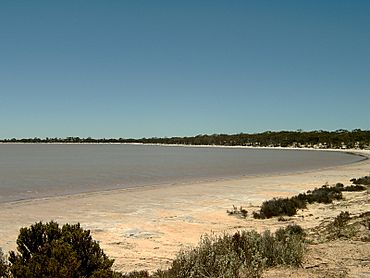Lake Gilles Conservation Park facts for kids
Quick facts for kids Lake Gilles Conservation ParkLake Gilles, South Australia |
|
|---|---|
|
IUCN Category Ia (Strict Nature Reserve)
|
|

The southern shore of Lake Gilles looking northeast
|
|
| Nearest town or city | Kimba |
| Established | 30 September 1971 |
| Area | 655.27 km2 (253.0 sq mi) |
| Managing authorities | Department for Environment and Water |
| Website | Lake Gilles Conservation Park |
| See also | Protected areas of South Australia |
Lake Gilles Conservation Park is a special protected area in South Australia. It is located in the northern part of the Eyre Peninsula. You can find it about 20 kilometers east of the town of Kimba. This park helps protect the unique nature of the area.
This conservation park was first created on September 30, 1971. Back then, it was called Lake Gilles National Park. It was later renamed Lake Gilles Conservation Park on April 27, 1972. More land was added to the park on August 5, 2010. This made the protected area even bigger.
What Makes Lake Gilles Special?
Lake Gilles Conservation Park is known for its interesting lake system. The lake is "ephemeral," which means it sometimes dries up. This creates a unique environment.
Around the lake, you can find special plants called samphire communities. These plants are tough and can grow in salty soil. On the eastern plains of the park, there are many mallee communities. These are areas with small, multi-stemmed eucalyptus trees. You can also see Western Myall trees and chenopod shrubs.
Animals of the Park
The park is a home for many different animals, especially birds. It provides important habitat for several bird species.
Some of the birds you might find here include:
- The Malleefowl, a unique ground-dwelling bird.
- The Slender-billed thornbill.
- The Thick-billed grasswren.
- Many different types of migratory waders. These are birds that travel long distances and use the lake as a resting or feeding spot.
How the Park is Protected
Lake Gilles Conservation Park is classified as an IUCN Category Ia protected area. This is the highest level of protection. It means the park is a "Strict Nature Reserve."
In a Strict Nature Reserve, the main goal is to protect nature as much as possible. Human activities are very limited. This helps keep the natural environment safe and undisturbed for the plants and animals that live there.


